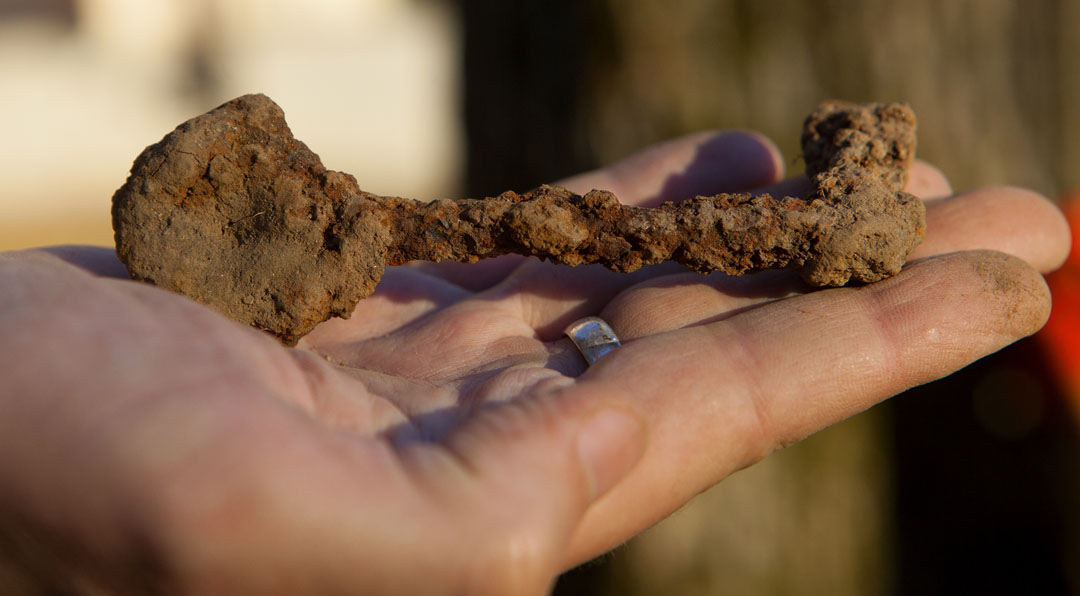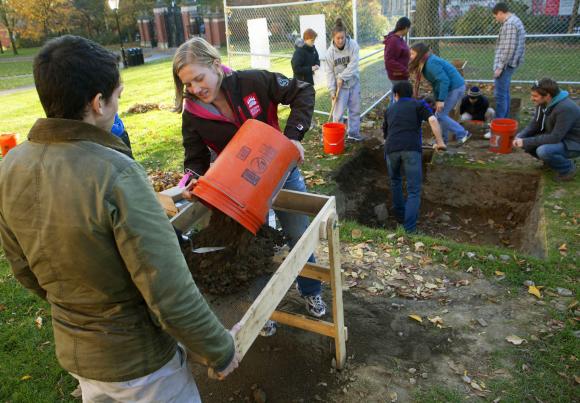PROVIDENCE, R.I. [Brown University] — On a recent brisk November afternoon, all was not exactly quiet on the Quiet Green. A glance north revealed chain-link fences cordoning off two large, neatly dug trenches. Several students were waist-deep in the excavated spaces, dumping shovelfuls of dirt onto the grass above. Others were busy sifting the earth into trashcans and carefully combing through the remnants. Occasionally, signs of discovery were evident. “Found something!” one would shout, lifting a fragment of ceramic or glass to get a closer look at it in the light.
The students, all part of the Joukowsky Institute’s “Archaeology of College Hill” class, had spent the last several weeks excavating the area in hopes of unearthing the remains of the foundation of the former president’s house, which occupied the space from 1770 to 1840. A geological survey of the area using radar had indicated that an L-shaped structure, possibly a corner of the foundation, might lie beneath the surface.
So far, though, the search had only yielded smaller artifacts: coins, glass and ceramic sherds, pipe stems and a jack. One of the more exciting discoveries was a large skeleton key, heavily encrusted with rust.
Still, that’s not to say that the search was for naught. There is little documentation on the house and its contents, aside from a few pictures and a cross-stitch rendition that hangs in University Hall. “What we’ve found will allow us to learn more about the fabric of the building and what it says about the history of the University,” said class instructor Linda Gosner. Much of the unearthed material, on first glance, could easily be dated to the 1800s, indicating that it was likely a remnant of the house and its occupants.
 ß
ß
With the approaching 250th anniversary of the University, Gosner said it seemed like an appropriate time to take up a dig of the house’s former location, a structure that no doubt played an important role in Brown’s beginnings. Last year’s class focused its efforts near the Hope College residence halls. In previous years, the class, which began 2006, conducted digs at the First Baptist Church in America and the John Brown House Museum.
For many of the students, the majority of whom are archaeology concentrators, it was their first foray into excavation and a chance to learn basic survey and analysis techniques without traveling abroad. Gosner said many of the students who take the class later go on to more intense summer projects overseas.
Students in this year’s class said they appreciated the opportunity to apply what they learned in the classroom.
“This is probably one of the most hands-on classes at Brown,” said senior Catherine Teitz.
Senior Tanya Olson, taking a break from sifting through the freshly dug dirt, agreed and said the thrill of discovery never gets old. “It’s funny how excited we can get.”
A few weeks later, the class was gathered in a lab in a small carriage house on Waterman Street. The fieldwork portion of the class was over and the students were starting to analyze their finds. Stacks of plastic baggies containing various artifacts lined the long tables. Some students sorted them by material, while others used toothbrushes to carefully clean centuries of dirt from fragments of ceramic, glass and metal.
In one corner, teaching assistant Andrew Dufton was helping two students identify several pieces of yellow and brown striped ceramic. Combing through online databases, they were comparing them to images of Staffordshire-style shipware, which bore the same distinct pattern. The style of dishware originated in England and was manufactured between 1675 and 1770.
“It seems to be a pretty good match,” said Dufton.
Next to him, sophomore Nathan Lovejoy was doing the same comparison for pieces of blue and white ceramic. He had found several images that looked similar, but was having more difficulty pinpointing an exact match.
“It’s nice to be finding something, but we’re still looking at a fairly significant amount of time searching.”
Teitz said that seeing all of the findings laid out together was quite a different experience from the piecemeal process of pulling them from the field.
“Going back now, it’s interesting to see the breadth of our assemblage and which pieces fit together. Now we can go back and think about everything as a whole.”
When the class left the dig site for the final time, the foundation remained undiscovered, although a significant amount of building material, including bricks, nails, and large stones, indicated that there likely was a building at the site. Next year’s class will begin its dig just south, where a geophysical survey of the area indicated that the house may have extended.
The dig also revealed the foundation of an s-shaped path that once cut across the green, evidence of the different phases the space has gone through over the years.
Reflecting on the semester’s finds, Gosner was optimistic, pointing out that not finding the foundation was meaningful in its own right. “Our results this year taught the students the important lesson that we don’t always find what we are looking for in excavations.”
Some of the more interesting artifacts, including the key, will eventually go on display in Rhode Island Hall.
The remainder will be used as comparative materials when future classes take up the task of coaxing the Quiet Green to give up the treasures it has held buried all these years.

